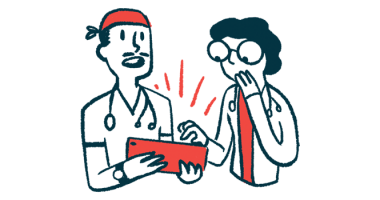Twice a Month, Porphyria Cancels My Life

In the early morning hours, my body jarred me awake. Before opening my eyes, I felt the onslaught of symptoms I knew would be coming before I put myself to bed last night.
Pain. Not a stomach cramp, not a tummy ache, but bullet holes riddled through my mid-section, smoldering coals deep in my guts, take-your-breath-away pain. I rolled over onto my side and began to curl around myself, which is when I felt my hands.
Neuropathy. Tingling, numb fingers and arms that hesitated to work when I brought them up to my forehead.
Headache. It felt like I ran into a brick wall. More accurately, it felt like someone dumped all of the bricks from the wall onto my forehead and the pressure at the base of my skull proved I did my best to hold my head high.
Sometimes I make a noise and disturb my fiancé, Michael, sleeping next to me. Other times, I’m not sure if I’ve made any sound at all, but I focus on breathing and heaving my body up and out of bed.
Sometimes it takes a tremendous amount of determination to move. When this happens, I find myself making deals with my body. You can lie here until I count down from five, then you have to move. The slow countdown begins. Often, it starts over.
On these mornings, I do what I can to take care of myself. I cancel my appointments or have Michael cancel them on my behalf. I schedule an outpatient treatment. I reach for medication and go back to bed or take myself out to my couch, where I can watch the morning light begin to stream through the windows.
Porphyria attacks like this wreak havoc on my central nervous system, causing severe pain, fatigue, and other symptoms that disrupt my life for days at a time. Acute intermittent porphyria (AIP) is a genetic disorder, but it’s caused by diet, stress, medication, and hormones. Clearly, some porphyria triggers are easier than others to control and avoid.
AIP cancels my life twice a month, coinciding with fluctuating progesterone levels, when I’m ovulating and when I’m pre-menstrual, at the beginning of my cycle. This means there’s 10 to 15 days every single month that I’m along for the porphyria ride, holding on tightly in case things get too rocky.
Here’s how one of my typical attacks might look: five to seven days of constipation, abdominal pain, headaches, insomnia, anxiety, and fatigue. I can manage an attack like this with outpatient treatment, rest, and medication at home.
Here’s how a rocky attack might look: 10 to 20 days of abdominal pain leading to a paralytic ileus, muscle weakness and paralysis that impacts my ability to walk, and nausea with vomiting that affects my ability to eat or drink anything. For an attack of this magnitude, I admit myself into the hospital for an extended stay. Fortunately, since receiving regular treatment, I’ve averaged just one severe, hospital-worthy attack per year.
Understanding my monthly cycle as the culprit of porphyria attacks is critical for managing my AIP, because it is the one thing I’ve been unable to get a handle on, despite my attempts at intervention. Early in my porphyria journey, my doctor and I experimented with a medication to rapidly induce a state of artificial menopause in my body. Essentially, this medication took my body’s hormonal fluctuations completely out of the equation.
This was a solid solution for my porphyria symptoms, but the trade-off was a whole host of problematic side effects. Nearly a year into this experimental hormone therapy, a bone density scan revealed bone loss as a direct result of the treatment. I knew it was time to stop.
Without a viable way to control my monthly cycle, I now opt for monitoring it and doing my best to live with it. Thanks to a fertility planning app, I know in advance which days I will require a little more space and outpatient treatments. I am blessed with an incredibly regular cycle; I can block out a handful of “porphyria days” every month. Because of this scheduling system, I am able to plan social and professional commitments out months in advance.
July may be easier than August or June, and some months I have more hard days than easy ones. But instead of keeping score, I’ve learned to better live in the moment and take advantage of the days I do live without acute pain.
***
Note: Porphyria News is strictly a news and information website about the disease. It does not provide medical advice, diagnosis, or treatment. This content is not intended to be a substitute for professional medical advice, diagnosis, or treatment. Always seek the advice of your physician or other qualified health provider with any questions you may have regarding a medical condition. Never disregard professional medical advice or delay in seeking it because of something you have read on this website. The opinions expressed in this column are not those of Porphyria News or its parent company, Bionews, and are intended to spark discussion about issues pertaining to porphyria.








Comments
Yvonne Borth
Hi Claire, when I read your article I couldn´t believe it....what you describe is exactly what I am going through. But I never needed to go to the ER yet. My pain and the burning sensation is quite manageable. Ovulation and the premenstrual phase knock me out almost every month. I am looking for answers... My porphobilinogen is higher than normal in attack-free phases, during an attack my urine wasn´t tested yet. My genetic testing for Porphyria came out negative with the geneticist's comment that such a test is not 100 % accurate. I'm desperate and don't know what to do now....Have you heard of false-negative genetic tests in Porphyria? Thank you for an answer. Stay strong! Yvonne